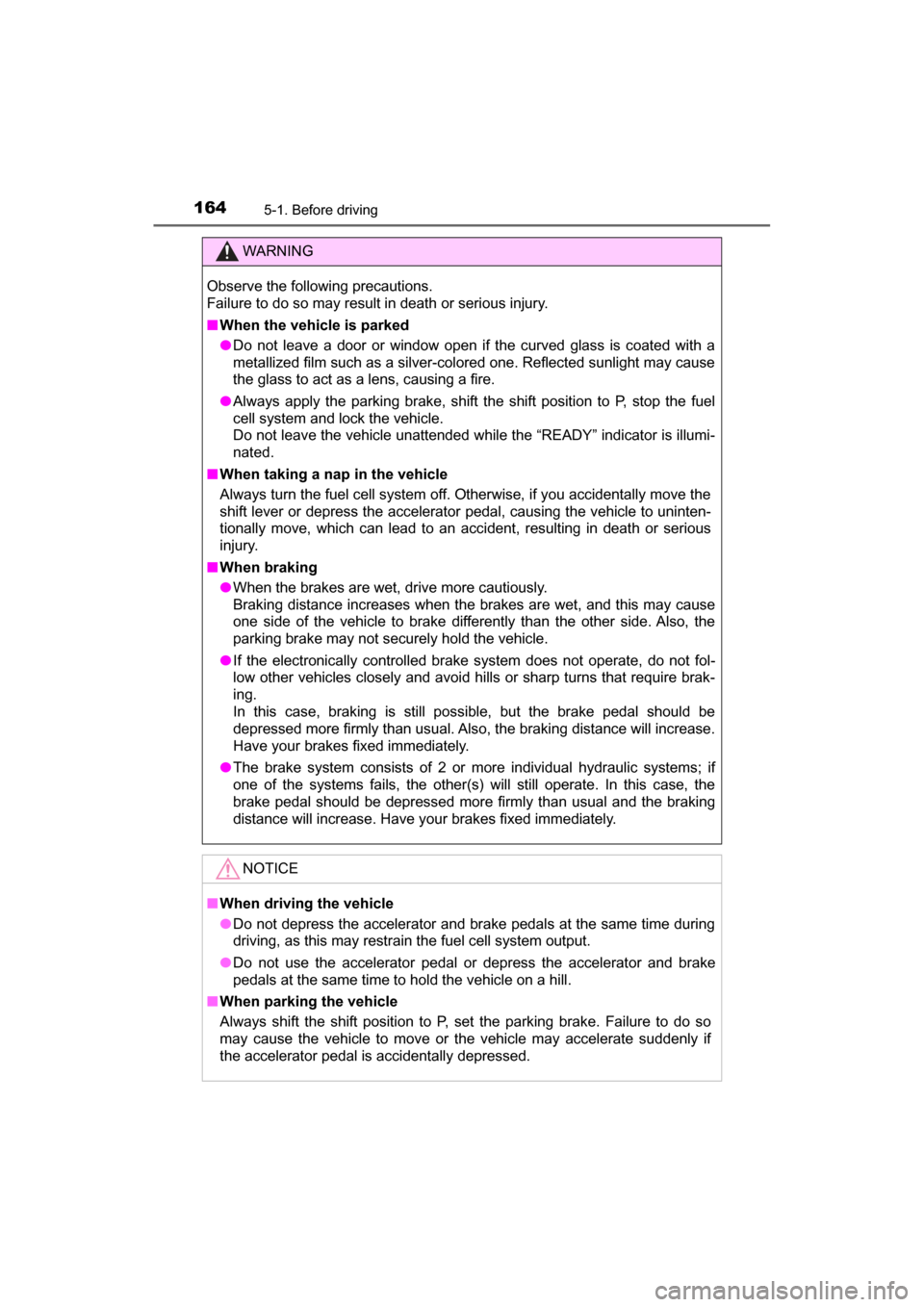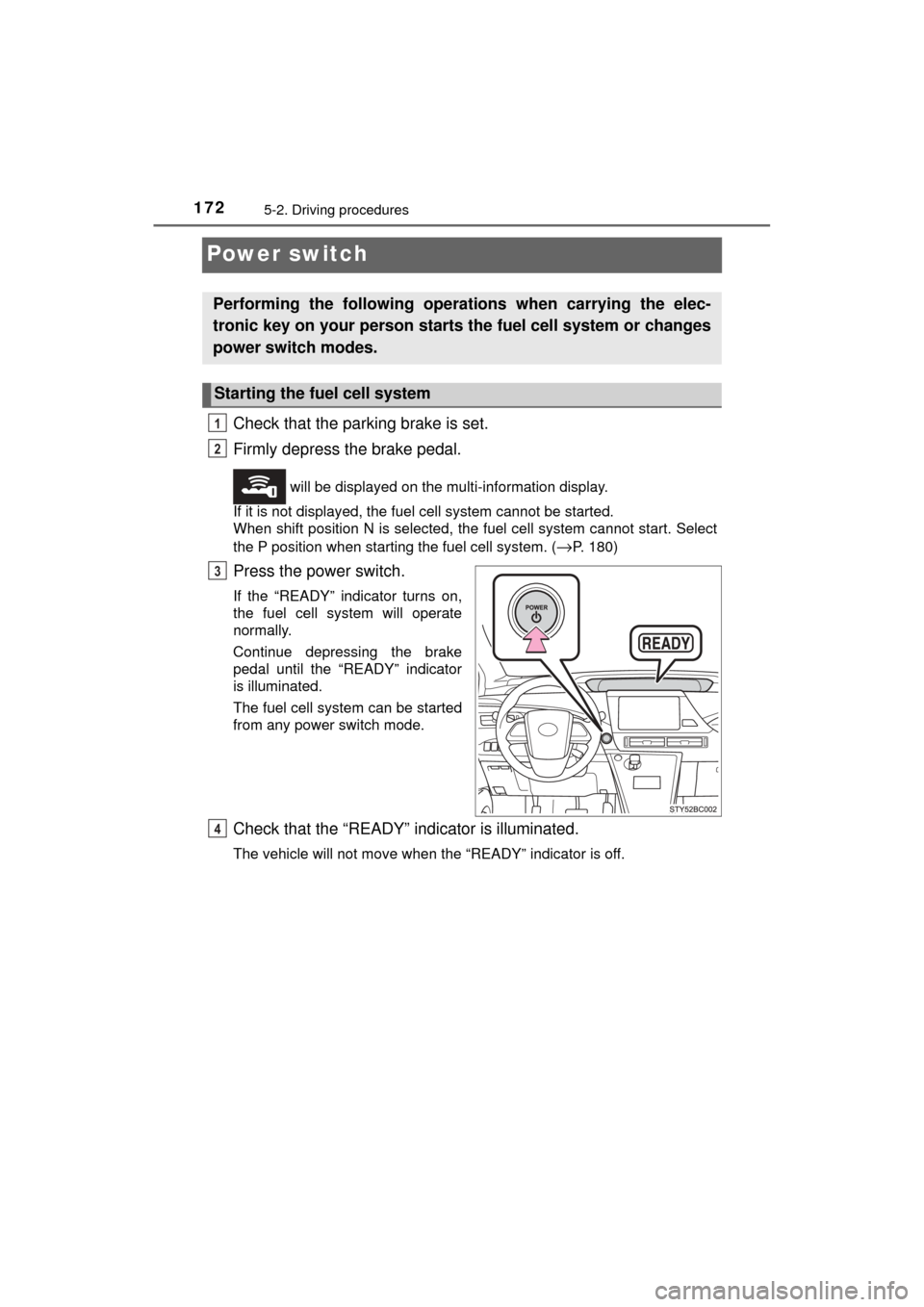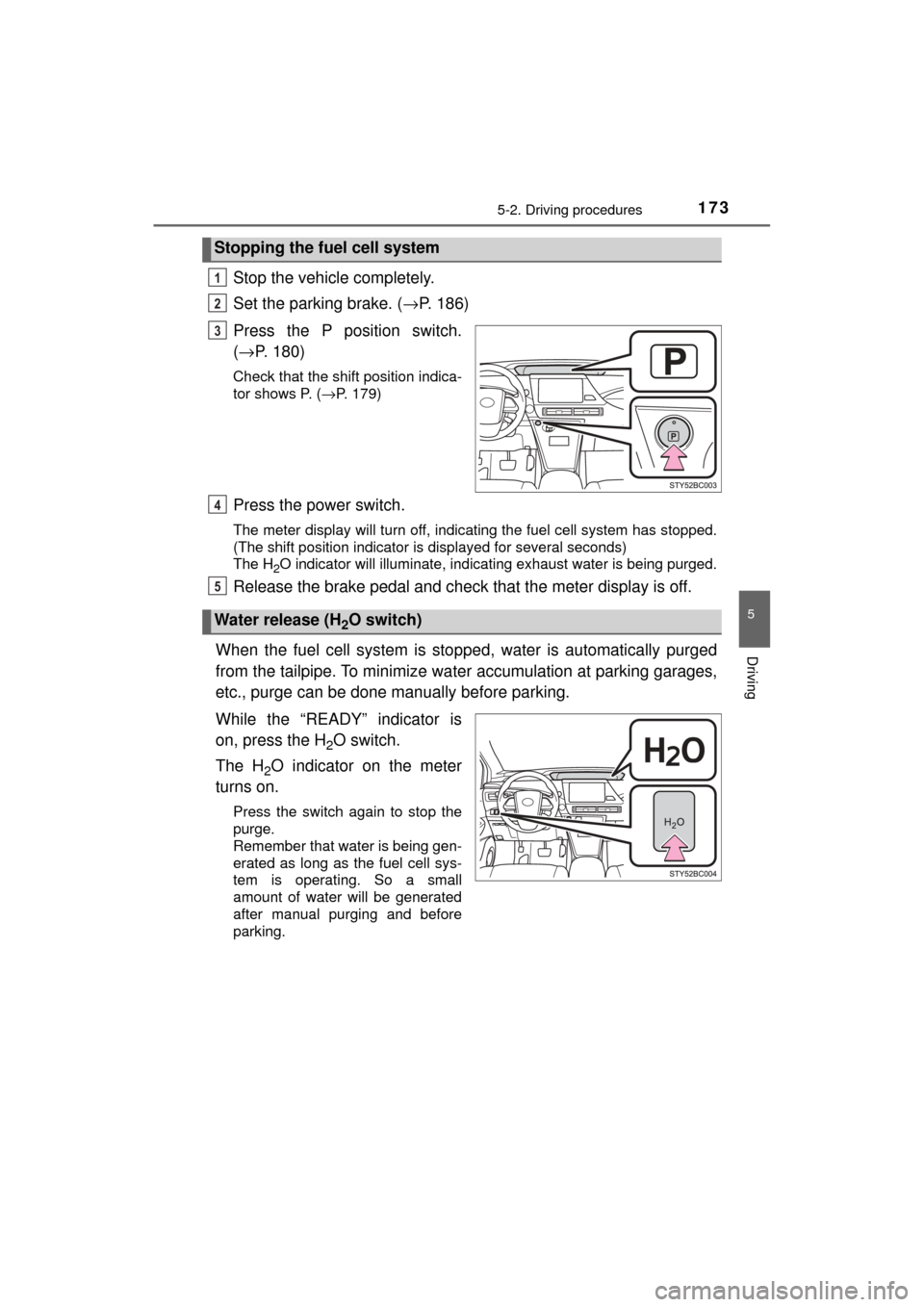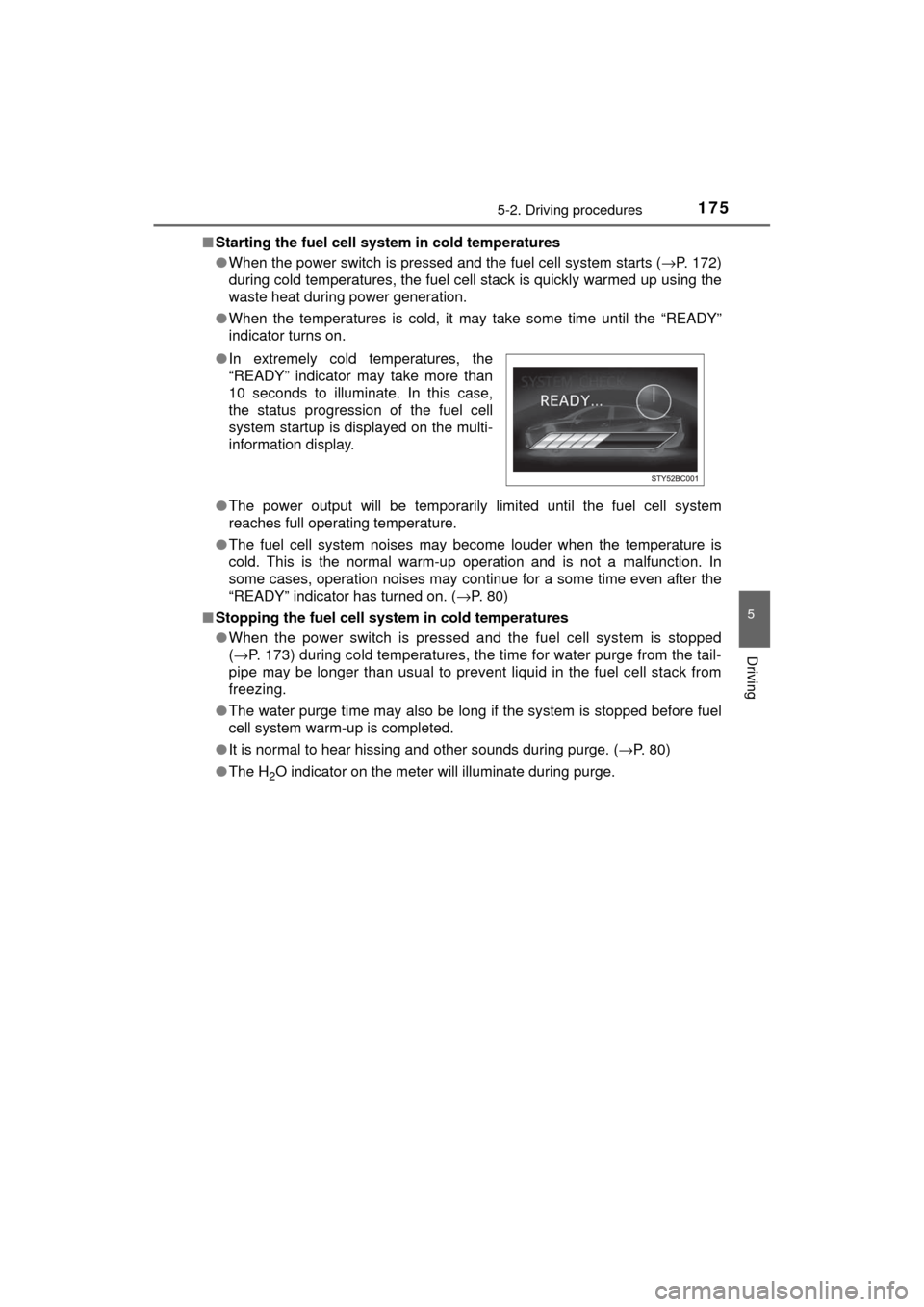2017 TOYOTA MIRAI fuel cell
[x] Cancel search: fuel cellPage 162 of 464

1625-1. Before driving
MIRAI_OM_USA_OM62023U
WARNING
Observe the following precautions.
Failure to do so may result in death or serious injury.
■When driving the vehicle
● Do not drive in excess of the speed limit. Even if the legal speed limit per-
mits it, do not drive over 85 mph (140 km/h) unless your vehicle has high-
speed capability tires. Driving over 85 mph (140 km/h) may result in tire
failure, loss of control and possible injury. Be sure to consult a tire dealer
to determine whether the tires on your vehicle are high-speed capability
tires or not before driving at such speeds.
■ When driving on slippery road surfaces
● Sudden braking, acceleration and steering may cause tire slippage and
reduce your ability to control the vehicle.
● Sudden acceleration or regenerative braking due to shifting could cause
the vehicle to skid.
● After driving through a puddle, lightly depress the brake pedal to make
sure that the brakes are functioning properly. Wet brake pads may prevent
the brakes from functioning properly. If the brakes on only one side are wet
and not functioning properly, steering control may be affected.
■ When changing the shift position
● Do not let the vehicle roll backward while a forward driving position is
selected, or roll forward while the shift position is in R.
Doing so may result in an accident or damage to the vehicle.
● Do not shift the shift position to P while the vehicle is moving.
Doing so can damage the transmission and may result in a loss of vehicle
control.
● Do not shift the shift position to R while the vehicle is moving forward\
.
Doing so can damage the transmission and may result in a loss of vehicle
control.
● Do not shift the shift position to a driving position while the vehicle is mov-
ing backward.
Doing so can damage the transmission and may result in a loss of vehicle
control.
● Shifting the shift position to N while the vehicle is moving will disengage
the fuel cell system. Regenerative braking is not available with the fuel cell
system disengaged.
● Be careful not to shift the shift position with the accelerator pedal
depressed. Shifting the shift position to any position other than P or N may
lead to unexpected rapid acceleration of the vehicle that may cause an
accident and result in death or serious injury.
After shifting the shift position, make sure to check the current shift posi-
tion using the shift position indicator. ( →P. 179)
Page 164 of 464

1645-1. Before driving
MIRAI_OM_USA_OM62023U
WARNING
Observe the following precautions.
Failure to do so may result in death or serious injury.
■When the vehicle is parked
● Do not leave a door or window open if the curved glass is coated with a
metallized film such as a silver-colored one. Reflected sunlight may cause
the glass to act as a lens, causing a fire.
● Always apply the parking brake, shift the shift position to P, stop the fuel
cell system and lock the vehicle.
Do not leave the vehicle unattended while the “READY” indicator is illumi-
nated.
■ When taking a nap in the vehicle
Always turn the fuel cell system off. Otherwise, if you accidentally move the
shift lever or depress the accelerator pedal, causing the vehicle to uninten-
tionally move, which can lead to an accident, resulting in death or serious
injury.
■ When braking
● When the brakes are wet, drive more cautiously.
Braking distance increases when the brakes are wet, and this may cause
one side of the vehicle to brake differently than the other side. Also, the
parking brake may not securely hold the vehicle.
● If the electronically controlled brake system does not operate, do not fol-
low other vehicles closely and avoid hills or sharp turns that require brak-
ing.
In this case, braking is still possible, but the brake pedal should be
depressed more firmly than usual. Also, the braking distance will increase.
Have your brakes fixed immediately.
● The brake system consists of 2 or more individual hydraulic systems; if
one of the systems fails, the other(s) will still operate. In this case, the
brake pedal should be depressed more firmly than usual and the braking
distance will increase. Have your brakes fixed immediately.
NOTICE
■ When driving the vehicle
● Do not depress the accelerator and brake pedals at the same time during
driving, as this may restrain the fuel cell system output.
● Do not use the accelerator pedal or depress the accelerator and brake
pedals at the same time to hold the vehicle on a hill.
■ When parking the vehicle
Always shift the shift position to P, set the parking brake. Failure to do so
may cause the vehicle to move or the vehicle may accelerate suddenly if
the accelerator pedal is accidentally depressed.
Page 165 of 464

1655-1. Before driving
5
Driving
MIRAI_OM_USA_OM62023U
NOTICE
■Avoiding damage to vehicle parts
● Do not turn the steering wheel fully in either direction and hold it there for
an extended period of time.
Doing so may damage the power steering motor.
● When driving over bumps in the road, drive as slowly as possible to avoid
damaging the wheels, underside of the vehicle, etc.
■ If you get a flat tire while driving
A flat or damaged tire may cause the following situations. Hold the steering
wheel firmly and gradually depress the brake pedal to slow down the vehi-
cle.
● It may be difficult to control your vehicle.
● The vehicle will make abnormal sounds or vibrations.
● The vehicle will lean abnormally.
Information on what to do in case of a flat tire ( →P. 381)
■ When encounterin g flooded roads
Do not drive on a road that has flooded after heavy rain, etc. Doing so may
cause the following serious damage to the vehicle:
● Fuel cell system stalling
● Short in electrical components
● Fuel cell system damage caused by water immersion
In the event that you drive on a flooded road and the vehicle is flooded, be
sure to have your Toyota dealer check the following:
● Fuel cell system
● Brake function
● Changes in quantity and quality of transmission fluid, etc.
● Lubricant condition for the bearings and suspension joints (where possi-
ble), and the function of all joints, bearings, etc.
If the shift control system is damaged by flooding, it may not be possible to
shift the shift position to P, or from P to other positions. When the shift posi-
tion cannot be changed from P to any other position, the front wheels will
lock, and you will be unable to tow the vehicle with the front wheels on the
ground, as the front wheels may be locked. In this case, transport the vehi-
cle with both front wheels or all four wheels lifted.
■ If the vehicle will not shift out of the P position
There is a possibility that the 12-volt battery is discharged. Check the 12-
volt battery in this situation.
Page 172 of 464

1725-2. Driving procedures
MIRAI_OM_USA_OM62023U
Power switch
Check that the parking brake is set.
Firmly depress the brake pedal.
will be displayed on the multi-information display.
If it is not displayed, the fuel cell system cannot be started.
When shift position N is selected, the fuel cell system cannot start. Select
the P position when starting the fuel cell system. (
→P. 180)
Press the power switch.
If the “READY” indicator turns on,
the fuel cell system will operate
normally.
Continue depressing the brake
pedal until the “READY” indicator
is illuminated.
The fuel cell system can be started
from any power switch mode.
Check that the “READY” indicator is illuminated.
The vehicle will not move when the “READY” indicator is off.
Performing the following operati ons when carrying the elec-
tronic key on your person starts the fuel cell system or changes
power switch modes.
Starting the fuel cell system
1
2
3
4
Page 173 of 464

1735-2. Driving procedures
5
Driving
MIRAI_OM_USA_OM62023U
Stop the vehicle completely.
Set the parking brake. (→P. 186)
Press the P position switch.
( → P. 180)
Check that the shift position indica-
tor shows P. ( →P. 179)
Press the power switch.
The meter display will turn off, indicating the fuel cell system has stopped.
(The shift position indicator is displayed for several seconds)
The H
2O indicator will illuminate, indicating exhaust water is being purged.
Release the brake pedal and check that the meter display is off.
When the fuel cell system is stoppe d, water is automatically purged
from the tailpipe. To minimize wa ter accumulation at parking garages,
etc., purge can be done manually before parking.
While the “READY” indicator is
on, press the H
2O switch.
The H
2O indicator on the meter
turns on.
Press the switch again to stop the
purge.
Remember that water is being gen-
erated as long as the fuel cell sys-
tem is operating. So a small
amount of water will be generated
after manual purging and before
parking.
Stopping the fuel cell system
1
2
3
Water release (H2O switch)
4
5
Page 174 of 464

1745-2. Driving procedures
MIRAI_OM_USA_OM62023U
Modes can be changed by pressing the power switch with brake pedal
released. (The mode c hanges each time the switch is pressed.)
Off
The emergency flashers can be
used.
ACCESSORY mode
Some electrical components such
as the audio system can be used.
“Accessory” will be displayed on
the main display.
ON mode
All electrical components can be
used.
“Ignition On” will be displayed on
the main display.
■ Auto power off function
If the vehicle is left in ACCESSORY mode for more than 20 minutes or ON
mode (the fuel cell system is not operating) for more than an hour with the
shift position in P, the power switch will automatically turn off. However, this
function cannot entirely prevent 12-volt battery discharge. Do not leave\
the
vehicle with the power switch in ACCESSORY or ON mode for long periods
of time when the fuel cell system is not operating.
■ Sounds and vibrations specific to a fuel cell vehicle
→P. 8 0
■ Electronic key battery depletion
→P. 1 1 8
Changing power switch modes
Page 175 of 464

1755-2. Driving procedures
5
Driving
MIRAI_OM_USA_OM62023U■
Starting the fuel cell syst em in cold temperatures
● When the power switch is pressed and the fuel cell system starts ( →P. 172)
during cold temperatures, the fuel cell stack is quickly warmed up using the
waste heat during power generation.
● When the temperatures is cold, it may take some time until the “READY”
indicator turns on.
● The power output will be temporarily limited until the fuel cell system
reaches full operating temperature.
● The fuel cell system noises may become louder when the temperature is
cold. This is the normal warm-up operation and is not a malfunction. In
some cases, operation noises may continue for a some time even after the
“READY” indicator has turned on. ( →P. 80)
■ Stopping the fuel cell system in cold temperatures
●When the power switch is pressed and the fuel cell system is stopped
(→ P. 173) during cold temperatures, the time for water purge from the tail-
pipe may be longer than usual to prevent liquid in the fuel cell stack from
freezing.
● The water purge time may also be long if the system is stopped before fuel
cell system warm-up is completed.
● It is normal to hear hissing and other sounds during purge. ( →P. 80)
● The H
2O indicator on the meter will illuminate during purge.
●
In extremely cold temperatures, the
“READY” indicator may take more than
10 seconds to illuminate. In this case,
the status progression of the fuel cell
system startup is displayed on the multi-
information display.
Page 176 of 464

1765-2. Driving procedures
MIRAI_OM_USA_OM62023U■
Parking in cold temperatures
●Water may automatically purge from the tailpipe, even when the fuel cell
system is off, in order to prevent liquid in the fuel cell stack, hydrogen pipe-
lines, etc., from freezing while parked during cold temperatures.
● It is normal to hear hissing and other sounds during purge. ( →P. 80)
● The H
2O indicator on the meter will illuminate during purge.
● Before storing the vehicle for extended periods of time in a location with
freezing temperatures, perform a cold-weather manual purge:
Turn the power switch to ON mode and press the H
2O switch.
Check that the H
2O indicator on the meter turns on.
While depressing the brake, press the power switch to start the fuel cell
system.
Check that the “READY” indicator turns on.
Press the power switch to stop the fuel cell system.
The water release is automatically performed. During water purge, the
H
2O indicator turns on. (Longer than normal water purge)
■ Conditions affecting operation
→P. 134
■ Notes for the entry function
→P. 135
■ If the fuel cell system does not start
●The immobilizer system may not have been deactivated. ( →P. 72)
Contact your Toyota dealer.
● Check that the shift position is P. ( →P. 179)
The fuel cell system cannot be started when the shift position is N.
If P position is not selected, “Shift to P position to start” will be displayed on
the multi-information display.
● Check that the fuel door is closed.
When the fuel door is open, the fuel cell system cannot be started.
Close the fuel door before starting the system. ( →P. 201)
■ If “Smart Entry & Start System malf unction See owner’s manual” is dis-
played on the multi-information display
The system may be malfunctioning. Have the vehicle inspected by your
Toyota dealer immediately.
■ If the “READY” indicator does not come on
In the event that the “READY” indicator does not come on even after perform-
ing the proper procedures for starting the vehicle, contact your Toyota dealer
immediately.
■ If the fuel cell system is malfunctioning
→P. 376
1
2
3